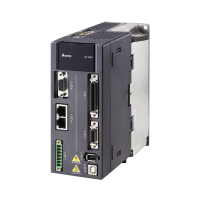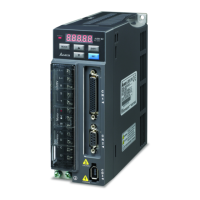AH Motion Controller – Operation Manual
7-18
En*
Receiving the logic state in front of this
instruction.
BOOL True/False (False)
Enabling the motion control function block
Execute Starting the motion control function block BOOL True/False (False)
Eno*
Transfering the logic state of the En input to the
following instruction which is connected in series
BOOL True/False (False)
The execution of the function block is complete.
Valid An output value is valid. BOOL True/False (False)
Busy
The motion control function block is being
BOOL True/False (False)
True when the axis is being controlled. BOOL True/False (False)
Command
Aborted(Ab
orted)
The execution of the motion control function
block is interrupted by another instruction.
BOOL True/False (False)
Error An error occurs in a function block. BOOL True/False (False)
*Note: The function of En/Eno is to receive or transfer the logic state in the program, and will not be included in the details
of the inputs/outputs of each motion control instruction.
A motion control function block has either the Execute input or the Enable input. The Execute/Enable input in a motion
control function block is used to start the motion control function block. A motion control function block generally has the
Busy output and the Done output. The Busy output and the Done output indicate the state of the motion control function
block. If the execution of motion control function block is to be interrupted by another motion control function block, the
CommandAborted/Aborted output will be added to the motion control function block. Besides, the Error output is used to
indicate that an error occurs when the motion control function block is executed.
A motion control function block has not only the Execute/Enable input, but also value/state inputs. The characteristics of
the value/state inputs are described below.
- Use of input values:
If the input that a motion control function block has is the Execute input, values are used when there is a
transition in the Execute input’s signal from low to high. If a new value is created, it becomes valid when the
Execute input is triggered again while the instruction is not in busy status.
If the input that a motion control function block has is the Enable input, values are used when there is a
transition in the Enable input’s signal from low to high. Compared with the Execute input, the Enable input is
used more often when an input value is updated repeatedly.
